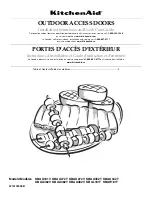
3
washer from the Paddle Arm Hinge Bracket. Depress the
Paddle Arm Hinge Bracket slightly and attach the Push
Bar to the bracket using the #10-32 Phillips screw and
lock washer just removed. Attach the End Cap to the
Retaining Bracket using the #10-24x½” oval-head Phillips
screw supplied.
8.
Install the Keeper Assembly.
Orient the Keeper
Assembly against the door jamb so that the Cam Latch
and the deadbolt on the lock are aligned with the
respective holes in the Keeper Cover. Remove the
Keeper Cover and install the Keeper Base onto the door
jamb with two flat-head screws (supplied) until screws are
snug, but not tight. Insert the Keeper Roller Pin into the ¼“
hole at the latch end of the Keeper. Pass the Keeper
Roller Pin through the Keeper Roller and into the second
hole. Install the #6-32 x ½“ Phillips-head (or optional
tamper-proof) retaining screw into the small hole at the
latch end to secure the Keeper Roller Pin. (
Note:
If the fit
is tight, it may be necessary to tap the pin into the holes
using a mallet.)
9. Adjust the Keeper Assembly.
Close the door, project
the deadbolt and adjust the Keeper Assembly so that the
door is tightly latched. Retract the deadbolt then, holding
the Keeper Assembly in place, release the latch and open
the door. Remove the Keeper Roller Pin and Roller (a
tightly-fitting pin may be driven out through the
1
/
8
“ access
hole accessible at the deadbolt hole), then fully tighten the
two flat-head screws securing the Keeper Base. Replace
the Keeper Roller Pin and Roller. Replace the Keeper
Cover and and the Lock Cover (Cam Latch must be in
“thrown” position) and check operation of the lock. If
necessary, repeat this step until proper operation is
achieved. Remove the Lock Cover once again.
10. Lock the Keeper Assembly.
When proper operation is
confirmed, mark and drill the hole for the third Keeper
Base Screw and install the remaining flat-head screw to
lock the Keeper Assembly in place.
Control Box
The Control Box is mounted on the hinged side of the
door, generally on the wall adjacent to the door frame, but
it may be extended to a hidden remote location if its visual
LED indication is not required.
1. Remove the Control Box cover.
2. Select a location for the Control Box on the hinged side
of the door so that the LED is clearly visible. Mount the
Control Box onto the door frame or adjacent wall using
the three #10x¾” self-tapping screws provided.
WIRING
Wiring from the Lock Assembly to the Control Box is
concealed within the door, exiting at the hinged side. A
protective Flexible Conduit loop (Model 271) transfers the
5-conductor cable from the door to the Control Box.
Note:
All holes drilled into the door for the passage of wires
should be deburred to prevent sharp edges from cutting
into the insulation.
1. Insert the loose end of the Flexible Conduit into the ª hole
in the Control Box and secure it with the retaining clip.
2. Mount the box end of the Flexible Conduit to the door
using the two #10x¾” screws provided. Be sure to leave
enough of a loop in the conduit for the door to open fully.
Drill a hole through the conduit bracket and into the door.
3. Referring to the Wiring Diagram, connect one end of the
5-conductor cable to the Control-Box Terminal Strip TS2.
4. Run the cable through the Flexible Conduit, through the
door, and out through the
3
/
8
” wire-entry hole under the
baseplate of the lock.
5. Connect one end of a UL-listed two-conductor #18AWG
cable (not supplied) to the Control-Box Terminal Strip
TS1, Terminals 1 and 2. Connect the other end to the
12Vac Power Transformer supplied.
6. Install the Control-Box cover.
Connection to Remote Life-Safety Equipment
National Fire Protection Association Standard NFPA101
requires that this lock be connected to an approved
supervised automatic fire-detection system or sprinkler
system that will automatically unlatch the lock instantly in
the event of an emergency.
1. To utilize a smoke detector to unlatch the lock instantly in
the event of a fire emergency, remove the factory-installed
1200W end-of-line resistor (5%, ½-watt; color code,
brown/red/red/gold) from the Control-Box Terminal Strip
TS1, Terminals 3 and 4; do not discard the resistor.
Connect one end of a UL-listed two-conductor cable,
#22AWG minimum, to the terminal strip (Terminals 3 and
4). Observing polarity indicated on the Wiring Diagram,
connect the other end of the cable to a 2-wire smoke
detector (see OPTIONAL EQUIPMENT: Recommended
Smoke Detectors) and install the end-of-line resistor
directly across the smoke-detector's terminals. (The end-
of-line resistor is not polarized.) Refer to the following
table for maximum cable length allowed between control
box and smoke detector.
2. To utilize a UL-listed supervised automatic fire detection
system, a normally-closed remote keyswitch or other
normally-closed device to unlatch the lock instantly in the
event of a fire (or other) emergency, connect one end of a
UL-listed two-conductor #22AWG cable to the Control-
Box Terminal Strip TS1, Terminals 5 and 6 and remove
the factory-installed jumper. Connect the other end of the
cable to a normally-closed fire-detection system,
keyswitch, or other normally-closed device. (If Terminals 5
and 6 are not used, the jumper must remain in place.)
Important! If connecting multiple locks to a normally-
closed device, do not intermix Terminals 5 and 6 between
units; that is, Terminal 5 of all units must be connected
Wire Size (AWG)
Maximum Cable Length
#18
500 feet
#20
350 feet
#22
250 feet


























